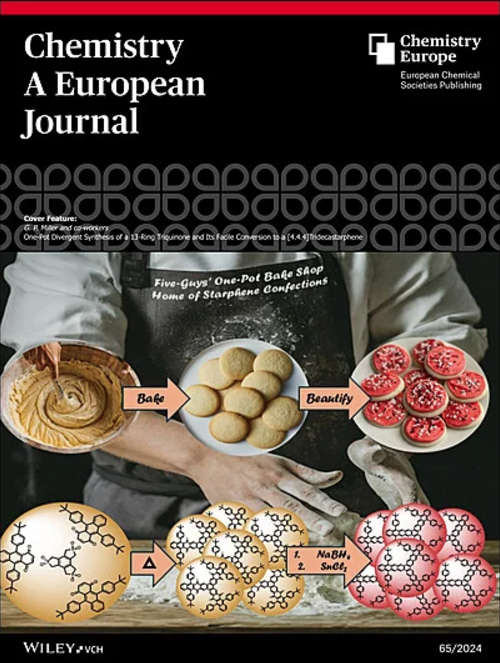部分共轭负电荷π-电子体系中离子对调制的双自由基性质。
IF 3.7
2区 化学
Q2 CHEMISTRY, MULTIDISCIPLINARY
引用次数: 0
摘要
合成了一种醌类二吡咯基二酮儿茶酚-硼配合物,该配合物由六元交叉共轭单元桥接两个吡咯-醌甲醚基团,以调节去质子化后形成的双基性。双阴离子表现出近红外吸收和电子自旋共振(ESR)信号,证实了双自由基的性质。变温(VT) ESR谱显示了基态单重态双自由基到三重态双自由基的热激发,提供了由共存阳离子和桥接硼基团调制的单重态-三重态能隙。本文章由计算机程序翻译,如有差异,请以英文原文为准。
Ion-Pairing-Modulated Diradical Properties in Partially Conjugated Negatively Charged π-Electronic Systems.
A quinonoidal dipyrrolyldiketone catecholate-boron complex, with two pyrrole-quinonemethide moieties bridged by a six-membered cross-conjugated unit, was synthesized to modulate the diradical character of the dianion formed upon deprotonation. The dianionic species exhibited near-infrared absorption and electron spin resonance (ESR) signals, confirming the diradical properties. Variable-temperature (VT) ESR spectra suggest the thermal excitation from the ground-state singlet diradical to the triplet diradical, providing singlet-triplet energy gaps modulated by coexisting cations and bridging boron moieties.
求助全文
通过发布文献求助,成功后即可免费获取论文全文。
去求助
来源期刊

Chemistry - A European Journal
化学-化学综合
CiteScore
7.90
自引率
4.70%
发文量
1808
审稿时长
1.8 months
期刊介绍:
Chemistry—A European Journal is a truly international journal with top quality contributions (2018 ISI Impact Factor: 5.16). It publishes a wide range of outstanding Reviews, Minireviews, Concepts, Full Papers, and Communications from all areas of chemistry and related fields.
Based in Europe Chemistry—A European Journal provides an excellent platform for increasing the visibility of European chemistry as well as for featuring the best research from authors from around the world.
All manuscripts are peer-reviewed, and electronic processing ensures accurate reproduction of text and data, plus short publication times.
The Concepts section provides nonspecialist readers with a useful conceptual guide to unfamiliar areas and experts with new angles on familiar problems.
Chemistry—A European Journal is published on behalf of ChemPubSoc Europe, a group of 16 national chemical societies from within Europe, and supported by the Asian Chemical Editorial Societies. The ChemPubSoc Europe family comprises: Angewandte Chemie, Chemistry—A European Journal, European Journal of Organic Chemistry, European Journal of Inorganic Chemistry, ChemPhysChem, ChemBioChem, ChemMedChem, ChemCatChem, ChemSusChem, ChemPlusChem, ChemElectroChem, and ChemistryOpen.
 求助内容:
求助内容: 应助结果提醒方式:
应助结果提醒方式:


